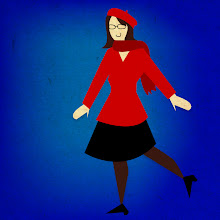21/02/2011
R is for Reference
Today I bring to you a very referential, fun and ambitious photography project: Où est Charlie ?, “Charlie” being the French version of the infamous lost reporter Wally (or Waldo, depending on which side of the Atlantic ocean you are).
And this time, Charlie (or Wally or Waldo) is live, hidden in the crowd of 14 large-scale pictures taken by a duet of photographers from the Goblin School: Max & Charlotte. (Go on Fubiz for a full view of the project and bigger versions of the pictures.)
The work is impressive, really fun and playful. However, I find really interesting and quite fascinating that the reference of a well-known children book is what's give the project its real interest. It wouldn't have been so attractive if it had been all about Where is John?
Whether it be some king of tribute, parody, or plain passing reference, pop culture gave us an enormous pool of common references to draw from, ranging from allusions to Star Wars or the Flash in Queen songs, to lines from beloved books, songs or movies, or visual symbols from world famous paintings.
Some of it is culture and generation specific, but what matters is that the use of common references seems to increase the 'value' and the enjoyment drawn from a creative project, as long as it still qualify as 'reference', and not the loathed ''plagiarism'.
But why is that?
There must be studies out there, backed-up with data giving supported answers (if you know of any, please share), but for myself I find at least two obvious answers.
1) References are comfort. They are easy, and give you, well, a point of references rather than throwing you cold turkey into a movie (or artwork, or song, or anything else) without any key to understand it. They give a welcome measure of familiarity, an indication or a starting point to analyze it.
In some ways, it's the same mechanism as symbolism; only references are not used as some kind of alphabet, with clear signification attached to each reference. They are more usually playing as a piece of common background, sometime obvious, sometime less so, used as an anchor.
2) The "common background" thing is the second part of the answer. It's a commonplace analysis that humans are social animals, and that they like to be part of a community. It's one of the pet principles of marketing guru Seth Godin: Tribes. In this regard, the use of references is like a secret password, a way to say: we like the same things, you and I, look, we share the same references. (And also: see, if you liked this *insert reference*, then you must like this too…)
Freemasons had complex symbols incorporated in paintings, teenagers have their secrets hand-shakes, and many, many people have quotes from Fight-Club, or citations from a philosopher, or Big Bang Theory references, or mention of a sport event and so on… As long as it ties them to a Tribe.
For an advertising person, a well handled reference is simply pure gold.
Libellés :
analysis,
Brainfood,
marketing,
photography
04/02/2011
3515 Google
Remember, remember, the 5th of Nov... before the internet, when for french people, looking for any information meant either going to the public library, buying a newspaper, or turning on the Minitel...
Yes, the Minitel, this beige box sitting near the phone with it bichromic pixel screen and access codes.
Google, with it's usual playfulness, created an access page untitled 3615 Google, mimicking the old Minitel entry page.

Capitalizing on nostalgia is almost always an useful move and I have to say, I like what Google did this time.
Yes, the Minitel, this beige box sitting near the phone with it bichromic pixel screen and access codes.
Google, with it's usual playfulness, created an access page untitled 3615 Google, mimicking the old Minitel entry page.
Capitalizing on nostalgia is almost always an useful move and I have to say, I like what Google did this time.
Libellés :
on the web
Subscribe to:
Comments (Atom)
